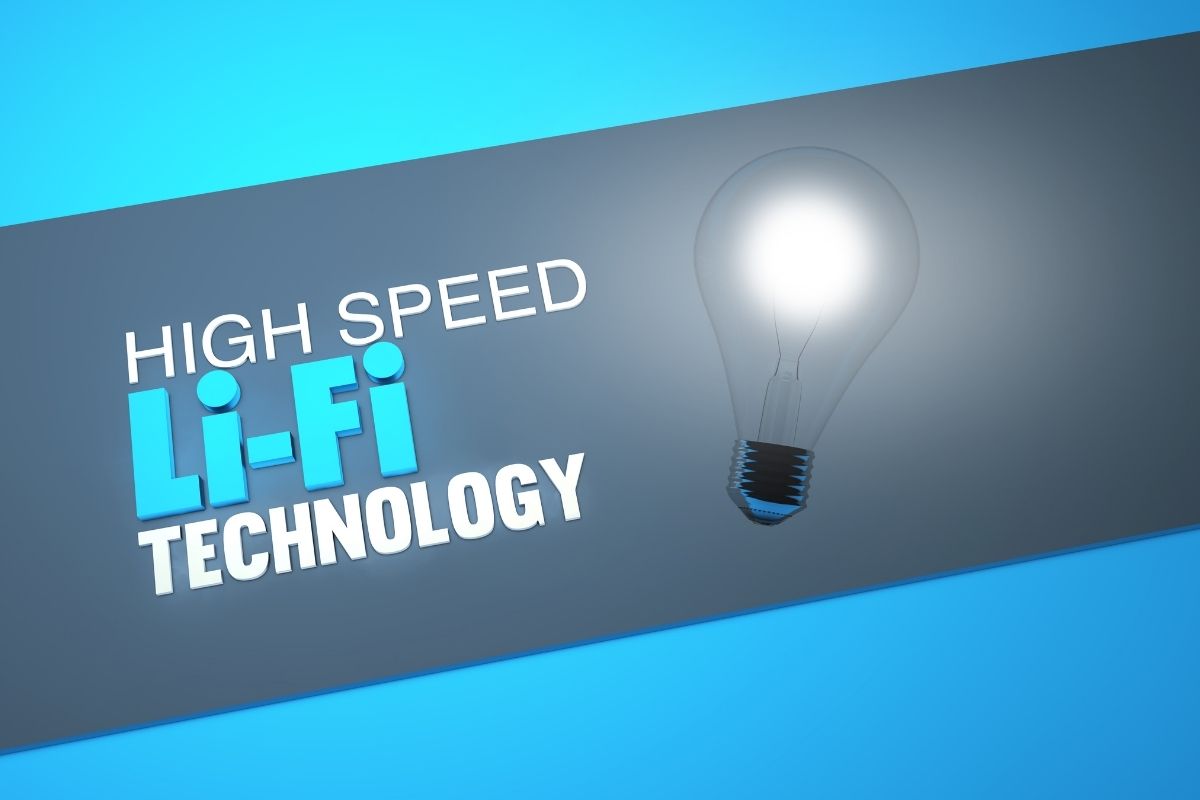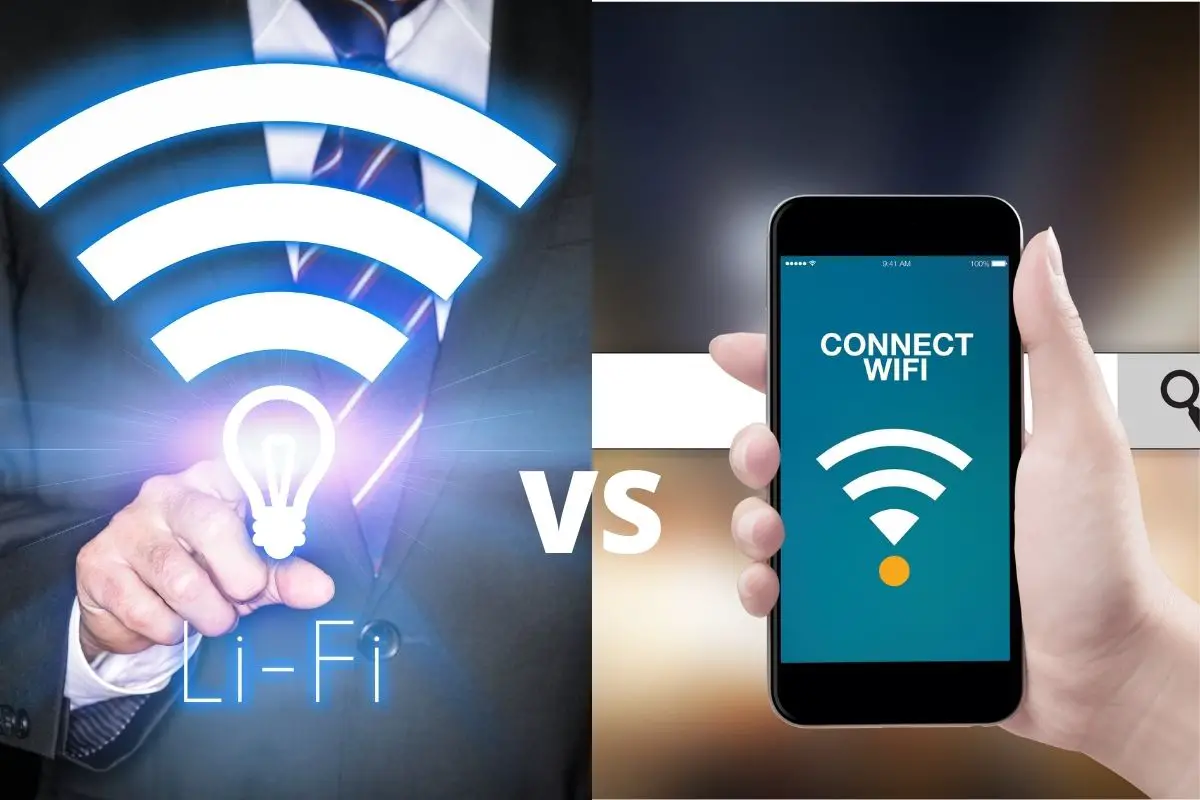If you're disappointed with your WiFi network’s performance, you'll be happy to know that there's a similar technology known as LiFi. LiFi is rising in popularity as a viable alternative to traditional WiFi.
WiFi and LiFi are two separate wireless data transmission and reception systems. That’s why it's critical to understand how they differ and how each outshines the other in certain situations.
In this article, we'll go over the difference between LiFi and WiFi, including their features, functioning operation, merits, demerits, applications, etc., so make sure to read until the end!

What Is LiFi?
LiFi, otherwise known as light fidelity, is a mobile wireless system that transmits data using light rather than radio frequencies. It’s a communication system that sends data at high speeds using a chip and a light source, typically ultraviolet light, visible light, and infrared light.
LiFi data transfers are much quicker than WiFi, which uses radio waves and is thereby slower. LiFi can boost your WiFi, 3G, and 4G connections’ bandwidth and speed.
How Does LiFi Work?
LiFi is a visible light communication technology, which means it acquires light signals using a photodetector and then transforms the data into streamable material with a signal processing device. The LiFi technology makes use of an LED bulb as a semiconductor light source since the energy supplied to an LED bulb can be muted or dipped at rapid speeds.
The technology allows an LED light bulb to produce light pulses invisible to the naked eye, and data can be transmitted to and from receivers within those pulses. The receivers can now obtain data and interpret the transmitted data.
This works similar to Morse code decoding, but at a much faster rate – millions of times per second.
Applications of LiFi
Let's dive into the applications of LiFi!
Hospitals
Mobile phones are not permitted in operation theaters since radio waves can interfere with monitoring equipment. They can even block the signals from such equipment, making the reports unreliable.
LiFi is the solution to these issues since it uses light instead of radio waves, and lights are a must-have in hospitals, or anywhere for that matter.
Safety Surroundings
The use of electrical equipment, including mobile phones, is often forbidden in explosion-prone areas. The use of LiFi to transport data will make data network configuration easier in these situations.
Aircrafts
Do you know why you aren't allowed to use mobile phones on a flight? It's because radio waves pose security risks.
So, LiFi is the way to go for airlines, as it will provide high-speed data without posing any security risks, making it a win-win situation for both airlines and travelers.
Power Plants
Radio transmissions and other forms of electromagnetic radiation are harmful to sensitive places, such as power plants and gas stations, as these waves can cause accidents such as fires.
That being said, a fast interconnecting data transfer is necessary to monitor demand and grid integrity in power plants.
LiFi solves this problem by enabling rapid data transfer without using radio signals, which also saves a significant amount of power.
Pros of LiFi
Now let’s go over some of the pros of LiFi!
Ensures Safety
Since light cannot flow through opaque materials, LiFi internet is the only option for users within a constrained region. Moreover, it cannot be intercepted and misused outside the operating region.
Data Density
Data density eliminates the need to share wireless bandwidth with other users, providing a better user experience. LiFi has a data density of approximately a thousand times more than WiFi, allowing for more data per square meter!
Location Services
Geofencing can be easily implemented in a LiFi network since these systems are fully networked, and each LiFi equipped light has its own unique IP address.
Effectiveness
LiFi uses the same infrastructure as WiFi, allowing for the reuse of light for communications. LED lights are incredibly energy efficient, and LiFi uses them for something we've never used them for – communication.
Availability
Light is ubiquitous, so availability is not an issue. You'll have internet everywhere there's a light source!
Cons of LiFi
- Coverage area is limited
- Only works indoors
- Light cannot penetrate through opaque objects
- LiFi’s range is significantly shorter than that of WiFi

What Is WiFi?
WiFi is a wireless networking standard that allows devices to interact without wires. Simply put, it's a high-tech digital radio that operates at frequencies in the electromagnetic spectrum within 2 and 5 gigahertz.
WiFi functions similarly to a local area network, except that it doesn't need cables or wires. Moreover, it comes built into modern devices like laptops, smartphones, digital cameras, and smart TVs!
WiFi also depends on a collection of industry standards that enable high-speed, secure communication between a wide range of access points, digital devices, and hardware.
How Does It Work?
There’s no connection per se between the sender and receiver in a WiFi network. Instead, they use radio frequency (RF) technology, a frequency in the electromagnetic spectrum. When an antenna receives an RF current, it generates an electromagnetic field that can travel over space.
An access point (AP) is the foundation of any wireless network. Its principal function is to emit a wireless signal that computers can identify and connect to the network. These access points can be reached from a distance of over 20 to 50 meters.
But you'll need a wireless network adapter for your computers and other devices to connect to an access point and join a wireless network.
Applications of WiFi
WiFi is used in various electrical devices and gadgets, thanks to its excellent functionality. Its numerous other uses include:
Military
WiFi technology is used in the military to provide vehicular communication, command posts, ad-hoc networking, personnel role radios equipment, battlefield communications, surveillance sensors, intelligent data collecting, and more.
Inventories
Employees use WiFi connections to conduct inventories in real-time in the company's database using PDAs, Tablet PCs, or Smartphones. This saves time as far as jotting down logistics of a broad region is concerned.
Healthcare
WiFi can be used to connect various medical equipment and devices, allowing for real-time monitoring of patient status. Wearable health-monitoring devices can be easily connected to a WiFi network, allowing medical practitioners in a distant location to check on their patients and provide advice as needed.
Pros of WiFi
Convenience
Multiple people can join a wireless network simultaneously. Connections can be created using the router or a hotspot technology in a matter of seconds and without any setup.
Ease of Use
Installing a wireless network system eliminates the need for cables, which are time-consuming to set up and can be unsafe for walking.
Multiple Features
WiFi is the answer to a lot of issues. You can share files with your buddies using WiFi, cast your screen to your TV, make calls over the internet, or send commands to other WiFi-enabled devices.
Wider Coverage
Wireless networks offer more exhaustive coverage than wired networks. Moreover, they can be extended to areas where wires and cables are not readily available.
Increased Possibilities
Development and manufacturing organizations have new opportunities to explore with wireless technologies by their side. WiFi devices open up more possibilities for IoT-related product development. It's also beneficial for designing or playing multiplayer games and accelerating the development of such apps!
READ MORE: Should you turn off your router at night?
Cons of WiFi
- Malware, hackers, and phishing scams can all disrupt wireless networks
- The more devices linked to a wireless network, the slower the internet speed will be
- Can produce radiation that’s harmful to human health
- Poor weather can sometimes decrease the internet connection speed
Difference Between LiFi and WiFi
Let's discuss the difference between LiFi and WiFi.
| Categories | LiFi | WiFi |
| Full Form | Light Fidelity | Wireless Fidelity |
| Data Transfer Speed | 1 Gbps | 150 Mbps to 2 Gbps |
| Medium of Transfer | Light | Radio Waves |
| Technology | IrDA compliant devices | WLAN 802.11 /b/g/n/ac/d standard |
| Coverage | Up to 10 meters | Up to 32 meters |
| Components | LED bulb, photodetector, and LED driver | Routers, access points, and modems |
| Frequency | 10,000 times the radio frequency spectrum | 2.4Ghz, 4.9Ghz, and 5Ghz |
| Operation | LiFi uses light signals from LED lights to transport data | WiFi uses radio waves to transport data through a WiFi router |
| Work Environment | Effective in a high-density area | Due to interference difficulties, WiFi can only operate in a less dense setting |
| Privacy | Data is safe and secure | Since radio frequency signals travel through walls, additional data protection solutions might be required |
Conclusion
Having discussed the difference between WiFi and LiFi, it's tough to pick one over the other since each has its own set of benefits and drawbacks.
A common misperception concerning LiFi systems is that they were designed to replace WiFi. Since most of the existing infrastructure was created to fit RF technology, replacing them to make space for newer technology would be costly and time-consuming.
As a result, we recommend you view LiFi as a complementary technology that adds to the performance of existing technologies and provides relief to the already overburdened radio frequency used for WiFi connections!


